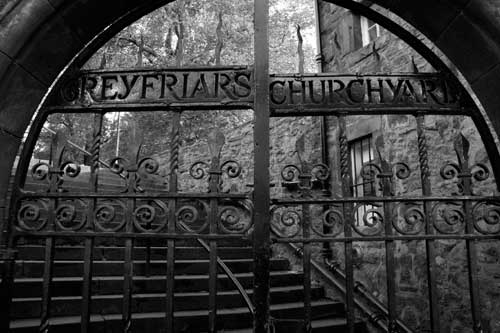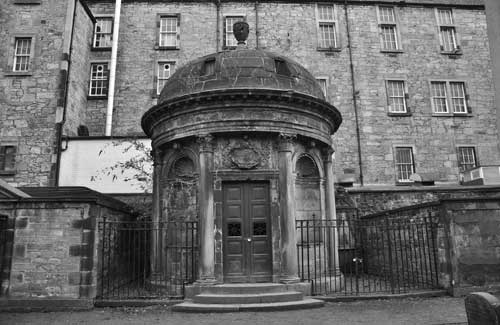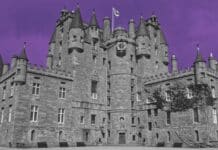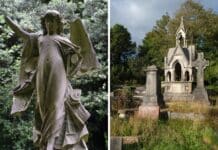MJ STEEL COLLINS looks at the dark and haunted history of Edinburgh’s Greyfriars Kirkyard

“We Scotch stand… highest among nations in the matter of grimly illustrating death…the classic examples of this art are at Greyfriars.” Robert Louis Stevenson.
RLS had a point. One thing that strikes you about Greyfriars Kirkyard is that it is, for lack of a better phrase, blinged out for death. It is a sprawl of worn headstones, half ruined mausoleums and lots of skeletons. My favourite in the latter category is the scary number built against the Kirk wall itself.
A Mountain of Corpses at Greyfriars Kirkyard
Standing on top of the betombed sloped, taking in the cracking view of Edinburgh, it’s possible that some people’s enjoyment of the scenery might be slightly dented when they realise that what they are standing on isn’t a natural hill at all.
In fact, the hill is actually the huge pile of the estimated half a million or more corpses that have been buried at Greyfriars; the top soil is pretty thin too, so it’s not unusual for the odd bone to pop out. Greyfriars has been in very high demand over its almost 500 year history.
The cemetery dates back to the 1560s; the land was originally a garden kept by monks, but was given to Edinburgh by Mary, Queen of Scots, to create an overflow cemetery to alleviate pressure on the graveyard at St Giles, which was bulging at the seams.
It didn’t take long for the new cemetery to be put in heavy use – people from all walks of life were laid to rest there – the rich in the rather ostentatious tombs and mausoleums, and the poor in unmarked pauper’s graves. This eventually led to the mountain of corpses that exists today.
There is even a plague pit.
Work on the church itself began in 1602, finishing in 1620. Not much of the original Greyfriars church remains; it was devastated by a fire in 1845 and was rebuilt. The Kirkyard itself also saw in the era of bodysnatching.
Mortsafes and other paraphernalia used to prevent the Resurrectionists can still be found. The small gatehouse where night watchmen kept an eye out for snatchers still stands today, though it is now used for The Creepy Wee Shop in the Graveyard, where the City of the Dead Tour ends.
The Covenanters
However, the most significant historical event Greyfriars took part in was probably the signing of the National Covenant February 1638. This was the culmination of great furore in the Scottish Kirk over Charles I trying to bring it more in line with the English Church, with the introduction of a common prayer book, and perhaps more significantly, himself as the head of the Kirk.
This rankled those in the Kirk as they believed only God, not a King, could be their leader, and they weren’t afraid to make it known. The gathering in Greyfriars in February 1638 was for those loyal to the Kirk to hear the reading of the National Covenant and sign, or otherwise make their mark, of allegiance to it. What followed was fifty years of bloody war as the Covenanters fought to keep control of their church.
It all came back to Greyfriars Kirkyard in 1679, over forty years after the signing of the National Covenant, with the Covenanters disastrous defeat at the Battle of Bothwell Brig, when around 400 Covenanters were held as prisoners in a section of the graveyard, known nowadays as The Covenanters Prison. The prisoners were kept here in the open air during the harsh winter, with scant food.
Many died, either being hung for treason, succumbing to disease or being shot trying to escape. Another 250 were sentenced to transportation, only for the majority to die when their ship sank just off Orkney.
Many who died within the prison were buried on the spot in unmarked graves. It was so grim, that it is actually regarded as the first concentration camp in history.
Bluidy Mackenzie
The man who oversaw all this was the Lord Advocate, Sir George Mackenzie, best known as ‘Bluidy Mackenzie’ because of his brutal treatment of the Covenanters. Ironically, he started his legal career defending Covenanters, but something changed along the way and he went after them with a vengeance.
When he died in 1691, not long after the Covenanting Wars ended, he was laid to rest in an elaborate mausoleum yards away from The Covenanters’ Prison. Almost immediately, it gained a reputation for being haunted. Schoolboys would dare each other to look through the barred door, challenging Mackenzie to rise from the grave.

The notion that Mackenzie’s tomb is haunted has carried on to the present day in the form of the Mackenzie Poltergeist, although the ghost itself has moved into a disused mausoleum within the Covenanter’s Prison itself. It has become one of Scotland’s best documented hauntings, the poltergeist seemingly attacking people visiting its lair as part of the City of the Dead Tours.
Quite what is going on isn’t clear, but it is violent enough for the gates to Covenanter’s Prison to remain locked outside of the tour hours.
Have you seen anything strange at Greyfriars Kirkyard? Tell us about it in the comments section!







